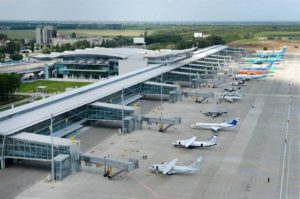
Kyiv-based Boryspil International Airport, the country’s largest airport, in January 2019 boosted passenger traffic by 14%, to 897,200 people compared with January 2017, the airport’s press service told Interfax-Ukraine. In January 2019, some 766,300 passengers handled by Boryspil Airport flew by regular flights (an increase by 21%) and 130,900 passengers travelled by charter flights (a decline by 17%).
In January 2019, the share of transfer passengers grew by 12% of the airport’s total passenger traffic, to 235,820 people.
As reported, the airport in 2018 handled 12.6 million passengers, or 19% up on 2017. In 2019, its passenger traffic is expected to grow by 14%. According to the airport’s management, the projected decrease in passenger traffic growth rates is associated with an increase in the absolute number of passengers.
Boryspil International Airport is the main airport of Ukraine, occupying a total area of about 1,000 ha. The airport has two runways: one with a length of 4,000 meters and a width of 60 meters, and the second with a length of 3,500 meters and a width of 63 meters. Four passenger terminals, postal and cargo handling complexes are located on the territory of the airport.
It services Ryanair flights to and from Ukraine along with Lviv’s Danylo Halytsky Airport.

Ukrainian enterprises increased imports of copper and copper products in terms of money by 51.8% in January 2019 compared with January 2018, to $8.22 million. Exports of copper and copper products decreased 57.5% over the year to $6.278 million, according to customs statistics released by the State Fiscal Service of Ukraine.
In December, copper and copper products were imported to the tune of $10,327 million, and copper exports were estimated at $7.130 million.
In addition, Ukraine in January 2019 boosted imports of nickel and products made of it by 55.9%, to $9.235 million (imports in December were estimated at $4.566 million), while imports of aluminum and products made of it fell by 2.8%, to $23.378 million ($33.745 million). Imports of, lead and products made of it rose by 5.1-fold, to $1.074 million ($1.195 million) and imports of zinc and zinc goods decreased 67.8%, to $112,000 ($378,000). At the same time, imports of tin and products made of it decreased 46.3%, to $3.674 million ($4.302 million).
Exports of aluminum and products made of it decreased 34.1% in January 2019, to $6.623 million ($7.902 million in December alone), while shipments of lead abroad decreased 62.4%, to $1.395 million ($1.773 million). Exports of nickel fell by 4.4%, to $175,000 ($541,000 in December).
Zinc exports in January 2019 amounted to $39,000 (some $28,000 in December 2018) compared to $7,000 in January 2018.
Exports of tin and products made of it in January 2019 were estimated at $3,000 (some $1,000 in December) compared to no exports in January 2018.

Production of vehicles in Ukraine in January 2019 grew by 56.7% compared with January 2018, to 893 vehicles, and the growth pace is linked to the assembly of Skoda passenger cars by Eurocar Plant, which grew by 73%, to 828 cars, the Ukrautoprom association has reported.
Eurocar improved its production 4.2-fold compared with December 2018.
The association said that today Eurocar is the only enterprise in Ukraine where the production of passenger cars continues.
At the same time, the production of commercial vehicles fell by more than 63%: only five vehicles were manufactured in a month (excluding AvtoKrAZ, which has stopped disclosing production information since August 2016), including four by Cherkasy Bus (two in January 2018), and one by Zaporizhia Automobile Plant (ZAZ, 30 vehicles)
The production of buses practically did not change: 60 buses were produced, against 59 vehicles a year earlier. The Cherkasy Bus (40 buses in January 2019 compared with 12 in January 2018) remained the leader of their production, the Chernihiv Automobile Plant (14 compared with 20 the previous year) was the second, the ZAZ and the Chasiv Yar Bus Plant made three buses each (compared with seven buses and 17 buses, respectively). Not a single bus was produced by Bogdan Corporation (three buses in January 2018).
Compared with December 2018, the output of buses in January decreased by 21%.
As reported, in 2018, the Ukrainian automakers produced only 6,616 vehicles. This was 23% less than a year earlier, and production capacity was loaded less than 1.5%.
At the same time, passenger car assembly decreased by 22%, to 5,660 cars (including Eurocar produced 5,659 cars, 7.9% less), commercial vehicles (excluding products of AvtoKrAZ) – by 73%, to 132 units. A slight positive trend was seen only in the production of buses – an increase of 2.5%, to 824 units.

Ukraine in January 2019 exported 455 tonnes of cheese, which was 23.5% up on January 2018. According to customs statistics released by Ukraine’s State Fiscal Service (SFS), cheese exports in monetary terms amounted to $1.5 million, which was 20% higher than the figure for the first month of 2018.
At the same time, imports of cheese in January 2019 totaled 1,180 tonnes, which was 35.7% more than in January last year. The imports in monetary terms increased by 30%, to $5.6 million.
Exports of Ukrainian creamery butter in January 2019 decreased by 28.5%, to 1,750 tonnes. The exports in monetary terms decreased by 37%, to $7.1 million. Imports of creamery butter, according to the SFS, decreased by 21%, to 90 tonnes ($585,000).
In January 2019, exports of condensed milk and cream decreased by 9%, to 2,150 tonnes. Ukraine supplied condensed milk and cream to the tune of $3.67 million, which was 3% less than in January 2018. Their imports decreased by 21%, to 167 tonnes ($325,000).
As was reported, Ukraine in 2018 imported 13,720 tonnes of cheese (37.1% up from 2017) and exported 8,340 tonnes of cheese (7.8% down from 2017).
Last year, exports of butter remained at the level of 2017, imports increased slightly, to 1,100 tonnes.
Exports of condensed milk and cream totaled 35,550 tonnes (24.1% down from 2017), imports were 2,360 tonnes (38.6% up from 2017).